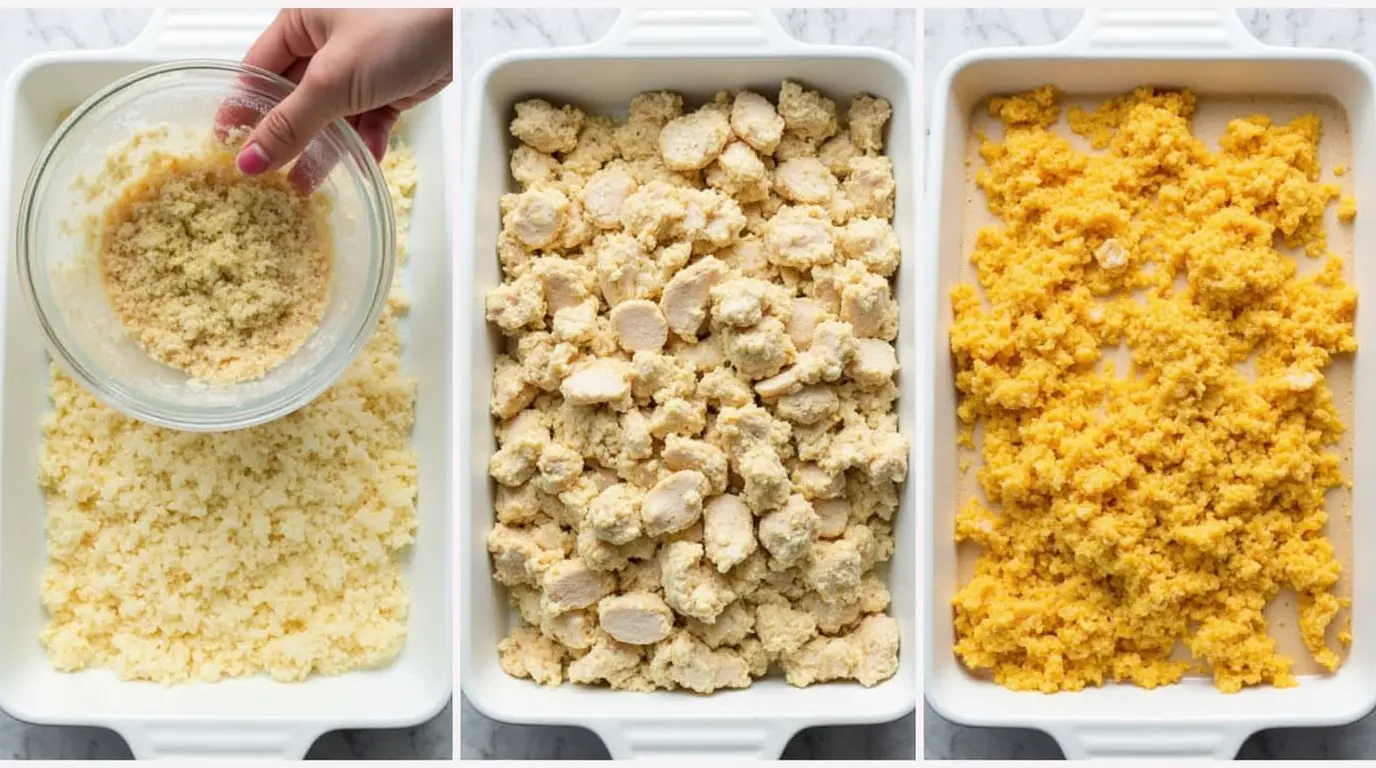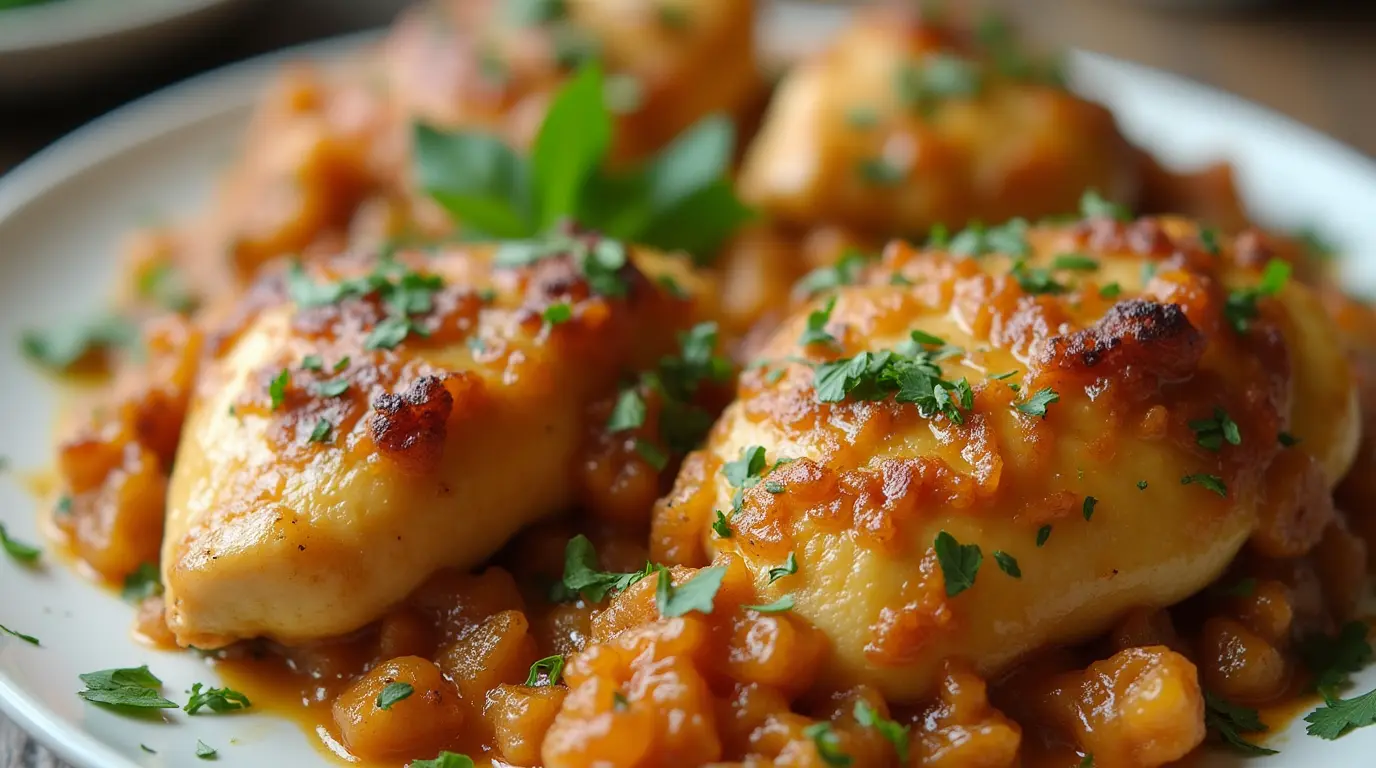Craving something warm, hearty, and nostalgic?
This Southern-style Chicken and Dressing is the kind of recipe passed down through generations, rich with herbs, tender chicken, and that golden, baked-on top. Whether it’s Sunday dinner or holiday tradition, this one always hits home.
Table of contents
Ingredients
Ingredients for chicken and dressing including chicken, cornbread, vegetables, and spices arranged on a kitchen countertop.
Main Ingredients
- Chicken:
- 1 whole chicken (about 4-5 pounds) or 4 boneless, skinless chicken breasts
- Preparation: If using a whole chicken, it should be boiled until tender and then shredded. If using chicken breasts, they can be boiled or roasted and then shredded.
- Cornbread:
- 2 cups crumbled homemade cornbread or store-bought cornbread
- Preparation: To make homemade cornbread, use 1 cup of cornmeal, 1 cup of all-purpose flour, 1 tablespoon baking powder, 1/2 teaspoon salt, 1 cup milk, 1/4 cup vegetable oil, and 1 egg.
- Vegetables:
- 1 large onion, finely chopped
- 2 celery stalks, finely chopped
- 1 green bell pepper, finely chopped
- 1 red bell pepper, finely chopped
Seasonings and Spices
- Salt and Pepper: To taste
- Sage and Thyme:
- 1 teaspoon dried sage
- 1 teaspoon dried thyme
- Poultry Seasoning:
- 1 tablespoon poultry seasoning
Additional Ingredients
- Chicken Broth:
- 3-4 cups chicken broth (homemade or store-bought)
- Butter:
- 1/2 cup (1 stick) unsalted butter, melted
- Eggs:
- 2 large eggs, lightly beaten
Preparation
Preparing the Chicken
- Cooking the Chicken:
- Boiling Method: Place the whole chicken or chicken breasts in a large pot and cover with water. Add a pinch of salt. Bring to a boil, then reduce heat and simmer for about 45 minutes to 1 hour (for whole chicken) or 20-25 minutes (for chicken breasts) until the chicken is cooked through and tender.
- Roasting Method: Preheat the oven to 375°F (190°C). Place the chicken breasts on a baking sheet, season with salt and pepper, and roast for 25-30 minutes or until the internal temperature reaches 165°F (75°C).
- Shredding the Chicken: Once the chicken is cooked and has cooled slightly, shred it into bite-sized pieces using two forks or your hands. Set the shredded chicken aside.
Making the Cornbread
- Ingredients for Cornbread:
- 1 cup cornmeal
- 1 cup all-purpose flour
- 1 tablespoon baking powder
- 1/2 teaspoon salt
- 1 cup milk
- 1/4 cup vegetable oil
- 1 egg
- Baking Instructions:
- Preheat your oven to 400°F (200°C).
- In a large bowl, combine the cornmeal, flour, baking powder, and salt.
- In a separate bowl, whisk together the milk, vegetable oil, and egg.
- Pour the wet ingredients into the dry ingredients and stir until just combined.
- Pour the batter into a greased baking dish and bake for 20-25 minutes or until golden brown and a toothpick inserted into the center comes out clean.
- Allow the cornbread to cool, then crumble it into small pieces for the dressing.
Preparing the Vegetables
- Chopping the Vegetables: Finely chop the onions, celery, and bell peppers.
- Sautéing the Vegetables: In a large skillet, heat a tablespoon of olive oil over medium heat. Add the chopped vegetables and sauté until they are tender and slightly golden.
Combining Ingredients

Mixing the Dressing
- Combining Cornbread, Chicken, and Vegetables: In a large mixing bowl, combine the crumbled cornbread, shredded chicken, and sautéed vegetables. Mix well to evenly distribute the ingredients.
- Adding Broth and Seasonings: Gradually add chicken broth to the mixture, stirring constantly to ensure even distribution. Add the salt, pepper, sage, thyme, and poultry seasoning. Continue to mix until everything is well combined.
Moisture Level
- Achieving the Right Consistency: The dressing should be moist but not soggy. If it feels too dry, add more chicken broth a little at a time until it reaches the desired consistency. Aim for a texture where the mixture holds together but isn’t overly wet.
- Adjusting Broth Quantities: Depending on the dryness of your cornbread and the amount of chicken, you may need more or less broth. The goal is to have a moist, cohesive mixture that holds together well.
Baking the Dressing
Oven Preparation
- Preheating the Oven: Preheat your oven to 350°F (175°C) to ensure it’s ready for baking the dressing.
- Preparing the Baking Dish: Grease a large baking dish with butter or cooking spray to prevent the dressing from sticking. This helps with easy serving and cleanup.
Baking Instructions
- Transferring the Mixture: Pour the dressing mixture into the prepared baking dish, spreading it out evenly to ensure it cooks uniformly.
- Baking: Place the dish in the preheated oven and bake for 45-60 minutes, or until the top is golden brown and the dressing is set.
- Checking for Doneness: To check if the dressing is done, insert a toothpick into the center. If it comes out clean, the dressing is ready. If not, bake for a few more minutes and check again.
Serving Suggestions
Accompaniments
- Suggested Side Dishes: Chicken and dressing pairs wonderfully with a variety of side dishes. Some popular options include:
- Mashed potatoes
- Green beans
- Cranberry sauce
- Fresh garden salad
- Roasted Brussels sprouts
- Serving Size Recommendations: For a hearty meal, serve a generous portion of chicken and dressing with two to three side dishes. This recipe is perfect for family dinners or holiday gatherings and can comfortably serve 6-8 people.
Garnishing
- Fresh Herbs for Garnish: Sprinkle freshly chopped parsley, thyme, or chives over the top of the dressing before serving. This adds a pop of color and enhances the flavor.
- Presentation Tips: Serve the chicken and dressing in a beautiful baking dish, and add a few sprigs of fresh herbs for an elegant presentation. You can also serve individual portions on plates with a side of cranberry sauce for a festive touch.
For more comfort food favorites, try our Grandma’s traditional beef stew, rich and full of flavor.
Tips and Variations
Tips for Success
- Common Mistakes to Avoid:
- Overcooking the Chicken: Ensure the chicken is cooked until just tender to avoid dryness.
- Not Sautéing Vegetables: Sautéing onions, celery, and bell peppers enhances their flavors and helps meld them into the dressing.
- Incorrect Moisture Level: The dressing should be moist but not soggy. Add broth gradually to achieve the right consistency.
- Making Ahead and Freezing:
- Make Ahead: Prepare the dressing up to the point of baking and refrigerate for up to 24 hours. Bake just before serving.
- Freezing: Assemble the dressing and freeze it in an airtight container. Thaw in the refrigerator overnight before baking.
Recipe Variations
- Adding Sausage or Other Meats: For a heartier dish, consider adding cooked sausage, bacon, or ham to the dressing mixture.
- Using Different Types of Cornbread: Experiment with variations like jalapeño cornbread, cheese cornbread, or even gluten-free cornbread to add unique flavors to your dressing.
Looking for more ways to use chicken? Try our creamy garlic chicken for a rich and satisfying main course.
Recap of Key Points
Creating a delicious chicken and dressing dish is a rewarding process that brings comfort and joy to any meal. Here’s a summary of the key steps:
- Ingredients: Gather the main ingredients including chicken, cornbread, vegetables, and seasonings.
- Preparation: Cook the chicken, make the cornbread, and sauté the vegetables.
- Combining Ingredients: Mix the crumbled cornbread, shredded chicken, sautéed vegetables, and seasonings. Adjust the moisture level with chicken broth.
- Baking: Preheat the oven, transfer the mixture to a baking dish, and bake until golden brown and set.
- Serving Suggestions: Serve with side dishes and garnish with fresh herbs for a beautiful presentation.
We hope you enjoy making and savoring this classic Chicken and Dressing recipe. Try it out for your next family dinner or holiday gathering, and share your own variations and tips. We’d love to hear how your dish turned out! Feel free to connect with us on social media and share your culinary creations
Frequently Asked Questions – FAQs
Can I Use Store-Bought Cornbread?
Yes, you can use store-bought cornbread to save time. Just make sure to crumble it well and check the consistency of the dressing.
How Do I Reheat Leftovers?
Reheat leftovers in the oven at 350°F (175°C) for about 20-25 minutes, or until heated through. You can also use a microwave, but the oven helps maintain the texture.
Can I Make This Recipe Ahead of Time?
Absolutely! Prepare the dressing up to the point of baking and refrigerate for up to 24 hours. Alternatively, you can freeze the assembled dressing and bake it after thawing.
Can I Use Different Types of Meat?
Yes, you can use different types of meat such as turkey, duck, or even a combination of meats for a unique flavor. Just ensure they are cooked thoroughly and shredded properly before adding to the dressing.

